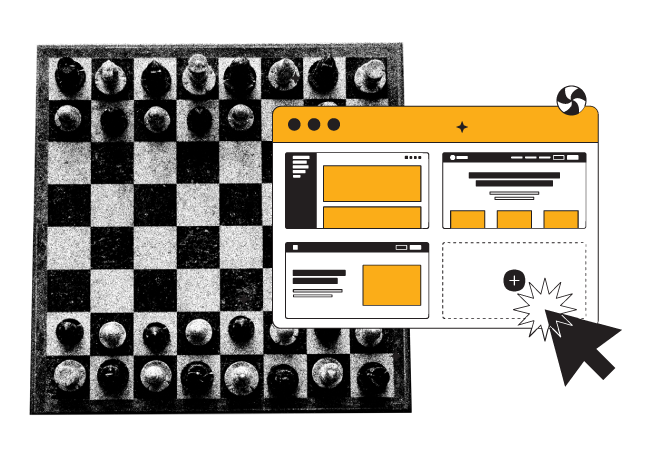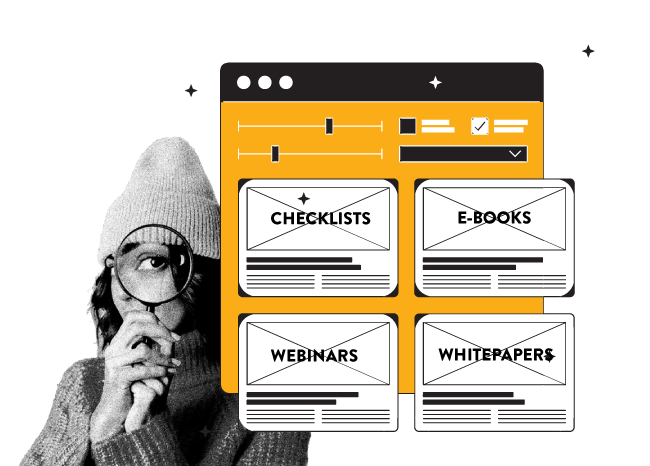
Gated content is controversial because it forces visitors to exchange information or subscribe to access the content, and that may turn off some visitors or even prevent bots from crawling and indexing it for search. However, gating content can be a way to filter only qualified leads from the masses, and ensure you get better leads from those who opt-in.
To create valuable gated content for your website and incorporate it into your marketing strategy effectively, there are several steps you’ll need to take, and several things you’ll need to understand.
What Is Gated Content?

Upon visiting a site with gated content, users are commonly taken to a landing page by a pop-up or a call-to-action (CTA) that offers them access to the content in exchange for providing their information, which will usually consist of their name and email address.
The pop-up or CTA will contain a link that brings users to a landing page, where they can learn more and/or see a preview of the gated content in question. The landing page is designed to direct users to take a specific action, which in most cases, is to enter their contact information into a lead capture form.
Once this information is submitted, the user will be able to view and download the gated content, and the business will have a new entry to add to its mailing list. In some cases, websites will make gated content accessible only to paid subscribers, rather than hiding it behind a public lead capture form.
Subscriber-only content is only accessible to users who have already signed up for a paid service or newsletter on the site, while lead-form gated content doesn’t require payment, and can be viewed by anyone who submits the right personal information. While they are very different, both types of gated content offer certain pros and cons.
Pros of Gated Content
 There are several notable benefits associated with using gated content for lead generation:
There are several notable benefits associated with using gated content for lead generation:
- Helps attract more qualified leads: By placing higher-value or more audience-targeted content behind a lead capture form, companies can filter out less-interested visitors from their lead generation efforts, and narrow their sales funnel to focus on more qualified traffic. This is because visitors with no interest in converting are less likely to share their personal information with companies in exchange for content.
- Enhances market segmentation: Market segmentation is the process of dividing markets into subgroups based on shared characteristics such as age, income, and interests. By using lead capture forms to ask visitors for details such as their job title and industry of employment, marketers can gain new insights that enable them to categorize different types of customers more accurately, and create different messages tailored to each segment of their audience.
- Increases the perceived value of content: In marketing, the perceived exclusivity of a product can significantly impact its perceived value, leading consumers to believe it is rarer or higher in quality. Gated content strives to achieve a similar effect. Because it’s more difficult to access, users may be more likely to assume that gated content has a higher value.
Over time, creating optimized gated content for your domain can lead more visitors to associate your brand name with quality. They’ll identify your site as a resource for valuable information, which can help strengthen credibility and foster audience trust.
Cons of Gated Content
 Just like many other marketing strategies, gated content is not without its shortcomings. There are several notable limitations and potential drawbacks of gated content that businesses should be aware of:
Just like many other marketing strategies, gated content is not without its shortcomings. There are several notable limitations and potential drawbacks of gated content that businesses should be aware of:
- Does not contribute to organic traffic: Because search engines typically can’t crawl pages that are hidden behind sign-up forms, websites can’t use gated content to attract organic visitors from search results. Consequently, putting too much of your website’s content behind a gate can limit your potential to attract organic traffic, rank for relevant keywords in that content, and otherwise support SEO. To benefit from search, at least some of your content should be free to access and focused on addressing relevant keywords.
- Potential for false contact information: While the promise of compelling gated content can persuade some visitors to enter their authentic contact information, it may also lead to some dishonest actors entering false information in an effort to bypass the lead capture form. While these people may still find the content interesting or valuable, they cannot be counted as qualified leads.
- Lead capture form prevents downloads: Just as gating a page can help filter out unqualified traffic, it can also substantially reduce the total number of people who view and/or download the content, as many visitors may simply be unwilling to share their contact information despite having some interest.
- Reduced opportunity for inbound links: When content is hidden behind a lead capture form, other websites are much less likely to link to it as a reference, even if it provides high-quality information. Because of this, gating a piece of content can significantly the number of inbound links it can earn. Highly targeted pieces of valuable content can greatly support a link building campaign, but if all your best content is behind a gate, you may struggle to earn links organically.
Because of these drawbacks, using gated content is not always a good idea, especially as part of an SEO campaign. However, it can be highly beneficial in some cases beyond search. To help you determine where and how to use gated and ungated content on your site, it’s critical to understand what makes them different.
Gated Content vs. Ungated Content
 While gated content is not ideal in every case, it can still be a highly valuable part of an effective marketing strategy. Most websites will benefit from incorporating a combination of gated and ungated content into their strategy, as each type serves a distinct purpose. The trick is knowing when to hide content behind a lead capture form, and when to leave it ungated.
While gated content is not ideal in every case, it can still be a highly valuable part of an effective marketing strategy. Most websites will benefit from incorporating a combination of gated and ungated content into their strategy, as each type serves a distinct purpose. The trick is knowing when to hide content behind a lead capture form, and when to leave it ungated.
Unless specified otherwise, all web content is ungated by default, and can be viewed by anyone without providing their personal information. It is up to you to decide which pages on your site (if any) will be gated and what information users must provide in order to access it.
In general, ungated content is more valuable to businesses that are trying to increase their search visibility and brand recognition, as a greater number of people are more likely to see and share it. Businesses that are still trying to establish trust and credibility in their industry should avoid using too much gated content — even interested visitors may be less willing to provide their contact information to unfamiliar sites.
Best Practices for Creating Gated Content
 If you structure and implement it correctly, gated content can have a major impact on lead nurturing campaigns. However, creating effective gated content comes with its own unique set of considerations. To maximize the performance of gated content on your site, there are several important things to keep in mind.
If you structure and implement it correctly, gated content can have a major impact on lead nurturing campaigns. However, creating effective gated content comes with its own unique set of considerations. To maximize the performance of gated content on your site, there are several important things to keep in mind.
Develop a Promotion Strategy
Because gated content is not visible to search engines, it does not contribute to organic traffic, and you can’t rely on organic discovery to promote gated pages. In order to ensure that your gated content is seen by your target audience, it’s important to develop an effective promotion strategy that extends beyond the CTAs on your website.
The best ways to promote gated content may vary depending on your target audience. Fortunately, there are a variety of platforms that you can use to target particular groups of consumers; including social media profiles, email newsletters, or ads on your other pages. Gated content is usually designed for a specific audience, and using the right promotional strategy can help you make your content visible to the right people.
Consider the Stages of the Buyer’s Journey
When creating any type of content for your business’s website, it’s important to consider the specific role that it will play in the buyer’s journey. This will help ensure the content resonates with its intended audience and helps support your overall marketing goals. The stages of the buyer’s journey are as follows:
- Awareness: In this stage, the buyer knows they have a problem or “pain point” but does not know how to address it. Content designed for this stage should focus on the pain point itself, rather than describing potential solutions.
- Consideration: At this stage, the buyer is actively researching different potential solutions to their problem. This research could include reading product reviews or asking for recommendations on social media. Gated content is often designed for customers at this stage, as it is intended to attract people who are already qualified as leads but still want to learn more.
- Decision: At this stage, buyers have decided they will make a purchase, but haven’t done so yet. Buyers at this stage will often compare prices on products from different sellers, or spend time discussing things like service rates and warranties with salespeople.
Each piece of content in your marketing funnel should be designed to correspond with one of these stages. Gated content is often more effective when developed for the consideration stage, as visitors at this stage have already shown some desire to learn more about your products or services, and are therefore more likely to fill out a lead capture form
For example, an ungated piece of content that offers general information, such as a blog post, is ideal for visitors at the awareness stage, and should be designed to have a broad appeal. Meanwhile, a fully gated report containing industry-specific research findings is better suited for audience members at the consideration stage, and should provide them with more detailed information about your products and/or services.
Prioritize Relevance and Value
Because gated content requires visitors to give you their personal information, it should always offer them something valuable in return. Many consumers may be reluctant to share their information with a business, but the promise of high-quality content can help incentivize more people to fill out the contact form and increase your potential to generate qualified leads.
To be worthwhile, the content should provide users with valuable insights that are relevant to your field, such as data or expert analyses of trends in your industry. It’s also critical to ensure the page is well-constructed and all the information it contains is accurate and up-to-****, as this will help establish your expertise and cultivate trust among readers.
Optimize Landing Pages
In addition to the content itself, the landing page you use to prompt customers is a critical part of a strong gated content strategy. The landing page is where users are led after clicking on a CTA or pop-up with a gated content offer. Here, they have the option to enter their personal information in exchange for access to the content, or simply to navigate away from the page.
To maximize your potential for conversions, there are several elements to include in your landing pages, such as:
- A clear, concise headline that’s prominently visible on the page;
- An offer that addresses the specific pain points of your target audience;
- Informative yet scannable copy that highlights the value of the gated content and the advantages of your products or services;
- Balanced visual elements that complement the text on the page;
- A relatively simple layout that keeps the focus on the CTA.
These considerations can help you generate well-designed pages that will capture users’ attention and quickly communicate the benefits of your offer.
Perform Analytics
While it’s commonly associated with lead generation, gated content can also be a valuable tool for audience analysis. Once a piece of gated content is posted on your site, analyzing its performance can provide you with a better understanding of your audience’s needs and enable you to improve your content strategy moving forward.
In most cases, not all of your gated content will perform equally well, and it’s important to understand why some pages do better than others. Metrics like the number of qualified leads and conversions that gated pages amass over a certain period are valuable for this analysis.
It’s also important to consider how the strategies used to promote content impact it’s visibility, as certain promotional methods may be more effective for certain audiences. Studying these metrics for both your gated and ungated pages can help you discover new ways to improve existing content, and identify how to create new content that will resonate more sharply with your audience.
Gated Content Examples

When developing a content gating strategy, it’s also important to consider what specific type(s) of content you’ll be incorporating. Many different types of gated content can be valuable for lead generation if used correctly, but some may be more beneficial for certain businesses than others.
You should always carefully consider your audience and industry when deciding on a layout for gated content. There are several common types of gated content to be aware of:
Checklists
Checklists are one of the shorter, simpler types of gated content. They outline a series of steps or items needed to complete a specific process or achieve a specific goal. Usually, the goals detailed in these checklists should relate to a common pain point for your business’s target audience. For example, a company specializing in storage unit rentals may benefit from publishing a spring cleaning or long-distance moving checklist.
Because they’re generally shorter than other types of content, checklists are not as informationally valuable, but are easier for users to fully digest, which can make their message more memorable and help increase the likelihood of conversions.
E-books
E-books are essentially in-depth guides that you can use to provide detailed coverage of a subject. They may vary significantly in length, and can be as short as a research paper, or as long as a novel. Organizations often use e-books to provide more comprehensive coverage of subjects that can’t be fully explained in blog posts.
Webinars
Webinars are online events that organizations host and broadcast to a select group of people (anyone who completes the lead capture form, in most cases) via the internet. They allow participants to learn about specific topics in an interactive and engaging way.
Webinars can incorporate a variety of different multimedia elements, such as video lectures and live chatting, and can be highly customized to fit the needs and preferences of your audience. Because of this, they often have a higher perceived value to users than more traditional types of written content.
Whitepapers
Perhaps the most formal and in-depth of all the gated content types, whitepapers are authoritative, long-form reports on complex topics. They are designed to help readers understand issues, solve problems, or make decisions. Similar to e-books, whitepapers should always cover topics that will be of interest to your target audience.
Because of their highly informative nature, whitepapers can be very effective at attracting leads when used as gated content. Additionally, published whitepapers on important topics in your industry can help you demonstrate your expertise and gain a reputational as a trustworthy source of information in your field.



